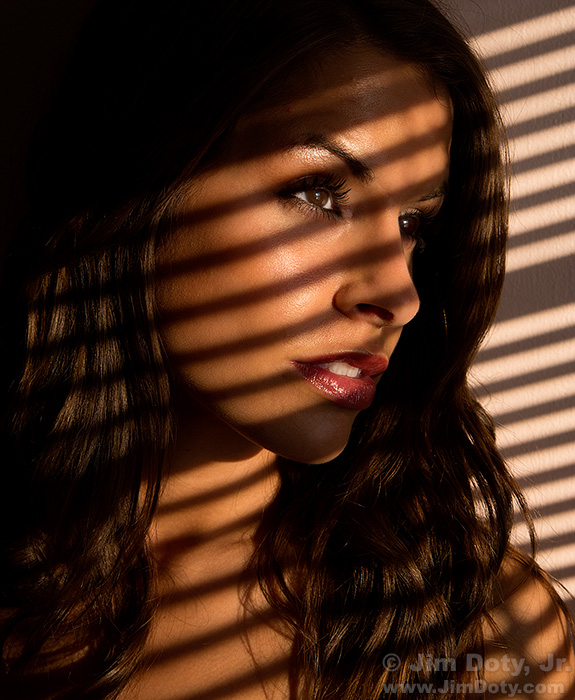One of the things I like about winter is the sunlight streaming through my studio windows at a low enough angle to create portraits using window blind shadows. In the summer the sun is too high for me to do this and get the angles I want.
As with any photograph, composition is the most important decision. The position of Kristina’s face is very important to get the effect I wanted. We turned her face toward the light but not so much that her left eye completely disappears. Her face is also turned at a slightly downward angle while her eyes look up at a slight angle into the light. This opens up the eyes. We adjusted her height just enough so a band of sunlight is across her right eye and much of her left eye. The photo wouldn’t work if her eyes (and especially the right eye) were in the shadow bands. It pays to experiment a bit with the angle of the blinds to get just the look you want.
I chose an aperture of f/11 to give me enough depth of field (near-to-far sharpness) so Kristina’s features would be sharp and the shadows on the wall behind her would be reasonably sharp.
Metering is critical. The photo can’t be metered like you see it above or the dark shadows and dark hair will fool the camera meter, causing the dark shadows to be lighter and the sunlit skin to be too light. The key is to open up the slats of the blind for maximum sunlight and meter just the skin, being careful not to include any dark hair. This will give you your “base” exposure, not your final exposure.
When the blinds are half closed they diffuse the sunlight, reducing the intensity of the light, so it is a good idea to add about 1/2 to 1 1/2 stops of exposure compensation (+1/2 to +1 1/2) to your base exposure to get your final exposure. For example, if your base exposure (metered with blinds open) is 1/100 at f/11, your final exposure will be around 1/50 at f/11 (using a longer shutter speed to add one stop of light). The amount of exposure compensation you add to your base exposure is determined by the rendition of skin tones that you want. The more “plus” compensation you add, the lighter the skin tones. See part 2 for an example.
Once the camera meter reading is locked in using the camera’s manual mode, close the blinds part way to get the bold shadows.
Photo Data: Canon EOS 5D Mark III. Canon EF24-105mm f/4L IS USM at 58 mm. 1/50 second, f/11, ISO 400.
(Originally written Feb. 5, 2013. Revised and expanded Feb. 25, 2014.)
Links
This is the first in a series of articles on exposure with links to more at the bottom of the page.
Exposure compensation is explained toward the end of this article on using your camera’s reflected light meter.
To learn more about depth of field, exposure, metering, working with stops, exposure compensation, portrait photography, and posing, read my book Digital Photography Exposure for Dummies. It is one of the highest rated photography books at Amazon.com with excellent reviews from professionals, advanced photographers, and beginners. Learn more here and order it at Amazon.com.
Recommendations for some of the best “how to” books on people photography.

